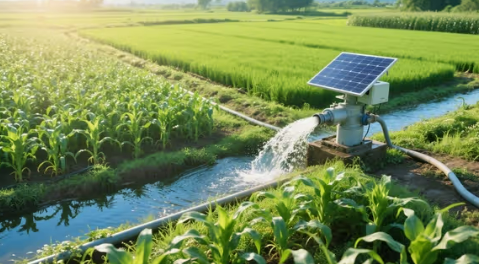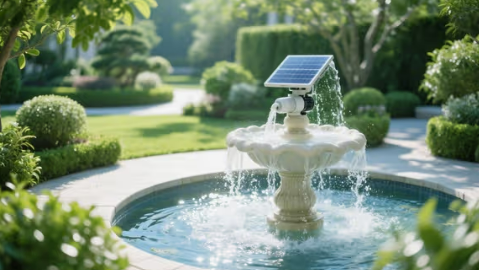Hey everyone, let’s talk about something that’s been quietly making waves in the world of sustainable water solutions—photovoltaic water pumps. You know, with all this buzz around energy transition and sustainable development, it’s no surprise that innovative tools like these are stepping into the spotlight. If you’ve ever wondered how we can solve global water supply issues without relying too much on fossil fuels or shaky power grids, well, photovoltaic water pumps might just be the answer we’ve been looking for. Let me break this down for you, so you can see why they’re such a big deal.

First Off: How Do Photovoltaic Water Pumps Actually Work?
Let’s keep it simple—no fancy jargon, I promise. A typical photovoltaic water pump system has three main parts, and each one plays a super important role. Think of them as a team working together to turn sunlight into water - moving power.
1. The Photovoltaic Array: Your Go - to Sun Catcher
First up is the photovoltaic array. It’s like a big net that catches sunlight, made up of lots of solar panels connected in series and parallel. Each of these panels is basically a tiny energy factory. When sunlight hits them, they use something called the photovoltaic effect (don’t worry, it’s just a fancy way of saying they turn light into electricity) to convert solar energy straight into DC electricity. Whether the panels are made of monocrystalline silicon, polycrystalline silicon, or amorphous silicon, they all do this job pretty efficiently. It’s honestly kind of cool to think that something so simple can turn sunlight—something we get for free every day—into usable energy for pumping water.
2. The Photovoltaic Pump Inverter: The Brain of the Operation
Next is the photovoltaic pump inverter. If the array is the sun catcher, this is the brain that keeps everything running smoothly. It takes the DC electricity from the array and converts it into AC electricity, which is what the pump needs to work. But here’s the really important part: it has a feature called Maximum Power Point Tracking (MPPT). Basically, this means it’s always checking how much sunlight is coming in and how much electricity the array is putting out. Then it adjusts the frequency and voltage it sends to the pump to make sure the array is always working at its maximum capacity. That way, we’re not wasting any sunlight—we’re using every bit of it to pump as much water as possible. It’s like having a smart assistant that makes sure your system is always performing its best.
3. The Pump: The Hard Worker That Gets the Water Moving
Last but definitely not least is the pump itself—the one that actually does the heavy lifting of moving water. Once it gets the AC electricity from the inverter, it’s ready to go. The type of pump you use depends on what you need it for. For smaller setups, you might use a pump powered by a brushless DC permanent magnet motor. For bigger systems, like those used in large - scale irrigation, you’d probably go with an AC asynchronous motor pump. These pumps are like the hardworking employees of the system—they take water from rivers, lakes, wells, or any other water source and move it to where it’s needed, whether that’s for watering crops, giving water to livestock, or supplying water to a village. No matter what the job is, they get it done.
Where Can You Use Photovoltaic Water Pumps? Spoiler: Almost Everywhere
One of the best things about photovoltaic water pumps is how versatile they are. They’re not just for one specific job—they can be used in all kinds of different scenarios. Let’s take a look at some of the most common ones.
1. Agricultural Irrigation: A Farmer’s Best Friend
If you’re a farmer, agricultural irrigation photovoltaic water pumps are a game - changer. Farming uses a lot of water, and the need for water changes with the seasons. The great thing is that when farmers need water the most—during the spring and summer growing seasons—there’s also the most sunlight. It’s a perfect match! In remote mountain areas or places near deserts where there’s no power grid or the power supply is 不稳定,these pumps are a lifesaver. They don’t need to be connected to the grid—they just use the sunlight that’s available right there. Farmers can just press a few buttons on the controller, and the pump will start pumping water when they need it. They don’t have to spend money on laying expensive power lines, and they don’t have to worry about high electricity bills. Whether it’s for drip irrigation in an orchard, spray irrigation in a field, or precise irrigation in a greenhouse, these pumps make sure crops get the water they need to grow. And when crops grow well, farmers get a better harvest—that’s a win - win for everyone.
2. Livestock Farming: Keeping Animals Hydrated on the Prairie
Out on the vast grasslands where livestock farming is common, things can get a bit tricky when it comes to getting water. The land is huge, there aren’t many people around, and laying power lines for traditional pumps is not only expensive but also really hard to do. That’s where livestock - dedicated photovoltaic water pumps come in. As soon as the sun comes up in the morning, these pumps start working, pumping water into storage tanks. So when the cows, sheep, or other animals get thirsty, there’s always fresh water waiting for them. In places like Inner Mongolia and Qinghai, where there are big livestock farms, many herders use these pumps along with water storage tanks. This way, their animals have access to water 24/7. And even in the winter, when the temperature drops and the weather gets harsh, these systems still work reliably. They don’t need a lot of maintenance, so herders don’t have to spend hours checking on them. It’s made their lives so much easier and has helped make livestock farming more sustainable.
3. Aquaculture: Saving Energy and Keeping Fish Healthy
Aquaculture—farming fish, shrimp, and other aquatic animals—also benefits a lot from photovoltaic water pumps for aquaculture. In fish ponds and shrimp ponds, it’s really important to keep the water clean and well - oxygenated. These pumps can be used in circulating water systems: they pump water from the bottom of the pond, send it through a filter to get rid of dirt and waste, and then send it back into the pond. This keeps the water clean and creates a healthy environment for the fish and shrimp to grow in. Some of these pumps can even work with aerators to add more oxygen to the water. That means farmers can raise more fish and shrimp in the same amount of space. And if there’s a power outage (which can be a disaster for aquaculture), these pumps keep working because they run on sunlight. In the southern parts of the country, where there are lots of outdoor fish and shrimp ponds, these pumps have become a popular choice because they save energy and make sure the farms keep running, even when the power goes out.
4. Landscape Fountains and Garden Systems: Looking Good While Being Green
Who doesn’t love a beautiful fountain or a nice garden with a small stream? But traditional fountains and garden water systems can use a lot of electricity. That’s why photovoltaic water pumps for landscape fountains are such a great idea. They don’t need any power cables—they run entirely on sunlight. During the day, when the sun is out, they turn on and create beautiful water displays. At night, when it gets dark, they turn off—perfect for when people are usually out enjoying the landscape. You’ll find these in resorts, rural revitalization projects, and tourist attractions. Not only do they make the place look more beautiful, but they also don’t produce any pollution. The environmental protection department loves them because they’re a great example of how we can have nice things while still taking care of the planet. It’s a great way to add a touch of green to any outdoor space.
5. Mountain Area Water Supply and Poverty Alleviation Projects: Bringing Clean Water to Those Who Need It Most
In many remote mountain villages, schools, and health clinics, getting clean water has always been a big problem. For a long time, people had to walk miles to get water, or they had to use water that wasn’t clean, which could make them sick. But now, with the help of photovoltaic water pumps for mountain area poverty alleviation, things are changing. The government has been using these pumps in many poverty alleviation water conservancy projects. These pumps are super easy to maintain—once they’re installed, you don’t have to do much to keep them running. As long as there’s sunlight, they pump water and provide clean drinking water to the people in these areas. The projects are easy to inspect and accept, and they don’t cost a lot to run. Local governments love them because they’re a cheap and reliable way to improve people’s lives. They’ve become a key part of improving living conditions in mountain areas and spreading the use of green energy in public services.
6. Emergency Drought Relief and Mobile Water Supply Systems: Saving Lives When Disaster Strikes
When disasters like droughts or floods hit, getting water to the affected areas quickly is crucial. That’s where mobile photovoltaic water pump systems for emergency relief come in. These are systems that are mounted on trucks or trailers, with solar panels and small pumps. They can be driven to wherever they’re needed, whether it’s a drought - stricken area that needs water for crops and people, or a flood - hit area that needs clean water to prevent the spread of disease. The best part is that they don’t need to be connected to the power grid. As soon as they arrive at the scene, they can start pumping water. In the southern parts of the country, where droughts and floods are common, these mobile systems have been a lifesaver. They help emergency workers get water to people quickly, which can make all the difference in saving lives and minimizing the damage caused by disasters.
Why Are Photovoltaic Water Pumps So Great? Let’s Count the Ways
Now that we’ve talked about how they work and where they’re used, let’s take a look at why they’re such a great option. There are so many advantages to using photovoltaic water pumps, it’s hard to list them all, but here are the most important ones.
1. They’re Green and Carbon - Free: Good for the Planet
First and foremost, photovoltaic water pumps are great for the environment. They run on solar energy, which is a renewable resource—we’ll never run out of it. Unlike traditional fuel - powered pumps, they don’t burn gasoline or diesel, so they don’t produce any exhaust fumes. And unlike pumps that rely on the power grid (which often gets its electricity from burning coal), they don’t contribute to carbon emissions. Every time you use a photovoltaic water pump, you’re doing your part to reduce air pollution and fight climate change. They’re a perfect example of how we can use technology to live in a more sustainable way.
2. They’re Reliable and Easy to Maintain: No Headaches
Another big advantage is that these systems are really reliable. They don’t have a lot of moving parts, which means there’s less chance of something breaking down. Compare that to traditional pumps, which have lots of gears and parts that can wear out over time. And when it comes to maintenance, it’s a breeze. Most of the time, all you need to do is clean the dust off the solar panels every once in a while and check that all the connections are tight. You don’t need to be a technical expert to do this—even people in remote areas who don’t have a lot of training can keep these systems running. That means less downtime and more time spent using the water you need.
3. They’re Cost - Effective in the Long Run: Save Money Over Time
I know what you’re thinking—photovoltaic water pumps probably cost a lot upfront. And you’re right, the initial cost of buying the panels, inverter, and pump is higher than buying a traditional pump. But here’s the thing: once you install a photovoltaic water pump, you don’t have to pay for electricity or fuel. Those costs add up over time, especially if you’re using the pump a lot. Let’s say you have a traditional pump that uses electricity. Every month, you get a bill for the electricity it uses. Over the years, that can be a lot of money. With a photovoltaic water pump, you don’t have those monthly bills. And since they’re easy to maintain, you don’t have to spend a lot of money on repairs either. So even though you spend more at the beginning, you’ll save a ton of money in the long run. This is especially true in areas where electricity is expensive or where the power supply is 不稳定 (so you don’t have to worry about paying for backup generators either).
4. They’re Flexible and Adaptable: Work Anywhere There’s Sun
Finally, photovoltaic water pumps are incredibly flexible. They don’t care where you put them, as long as there’s sunlight. You can use them in remote mountain areas, on vast grasslands, in deserts, or even in temporary emergency camps. There’s no need to worry about whether there’s a power grid nearby—they create their own power. And you can easily adjust the system to fit your needs. If you need to pump more water, you can add more solar panels. If you need to pump water to a higher place, you can choose a more powerful pump. They’re like a one - size - fits - all solution that can be
customized to meet any water - pumping need.
What Does the Future Hold for Photovoltaic Water Pumps?
Right now, they’re mostly used in agriculture, livestock farming, and aquaculture, but I can see them being used in new areas soon. For example, they could be used in seawater desalination projects—turning saltwater into freshwater using solar energy. They could also be used in ecological restoration projects, like pumping water to dry rivers or lakes to help bring them back to life.
In the coming years, I think photovoltaic water pumps will become an important part of our infrastructure for a low - carbon society. They’ll help us solve two big problems at once: the need for clean, reliable water and the need to reduce our reliance on fossil fuels. And as more people around the world learn about their benefits, they’ll become even more popular.
Wrapping It Up
At the end of the day, photovoltaic water pumps are more than just a piece of technology—they’re a solution to some of the biggest challenges we face today. They provide clean water to people who need it, help farmers grow more food, keep livestock healthy, and protect the environment. They’re reliable, cost - effective, and flexible, and they have the potential to change the way we think about water supply.
I, for one, can’t wait to see what the future holds for these amazing systems. Whether you’re a farmer looking to save money on irrigation, a herder needing water for your livestock, or someone who cares about the environment and wants to use more green energy, photovoltaic water pumps are definitely worth considering. Let’s keep an eye on them—because I think they’re going to be a big part of building a more sustainable future for all of us.
If you're interested in learning more about our solar energy storage offerings, we encourage you to explore our product line. We offer a range of panels and battery that are designed for various applications and budgets, so you're sure to find the right solution for your needs.
Website:www.fgreenpv.com
Email:Info@fgreenpv.com
WhatsApp:+86 17311228539















